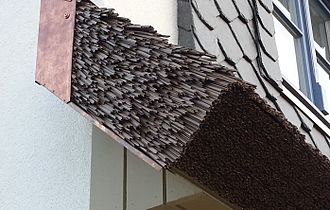Artificial reet

Artificial reet (also known as synthetic pipe, synthetic reed , synthetic roof reet, artificial reed ) is one of the hard roofing materials . Artificial thatched roofs in shingle shape look similar to a natural roof , but have z. B. not the typical curves and are very homogeneous in the view.
variants
There are two different types of artificial turf: on the one hand, artificial turf in shingle form or mat form and on the other, artificial tread in bundles.
The artificial reed in the form of shingles consists of a large number of closed or open extruded plastic tubes , which are individually sorted or welded to one another or connected in some other way. The purpose of this sorting is to show the surface properties and the course of a natural thatched roof . The individual bundles consist of a large number of extruded plastic tubes which are conical and whose color differs in nuances, as with artificial thatch in mat form. Both variants are mounted on roof boarding and not on roof battens like conventional natural thatch.
properties
In most cases, due to its fire behavior, artificial reet belongs to the area of hard roofing , which is subject to DIN 4102 Part 4 and is therefore resistant to radiant heat and flying sparks.
Artificial reed has been developed to improve the natural negative properties of natural reed.
Advantages of artificial reet are:
- Possible use in buildings with insufficient roof pitch,
- if the fire distance to the neighboring building is too small,
- with high fire protection regulations,
- for customers who want a thatched roof that is maintenance-free and free of decomposition
- Depending on the material used in the color pigments, artificial shingles are colourfast for a long time and therefore result in a permanently optically homogeneous roof covering.
- The plastic material hardly forms a breeding ground for pests.
- No maintenance is required, soiling can be cleaned with a steam jet device. There are therefore no operating costs. Any storm damage can be easily removed by replacing the shingles.
- Artificial reet can withstand wind speeds of up to 200 km / h.
However, the disadvantage is:
- it is not a renewable resource
- Artificial thatched shingles only resemble a thatched roof because, among other things, they do not have the typical curves.
- Artificial thatch in Bunden differs significantly less from a natural thatched roof, but here too the difference can be seen in the details, especially for a specialist.
- Artificial thatched roofs are usually more expensive to buy than natural thatched roofs, but the costs are put into perspective by the longer service life.
Laying artificial reet
The foundation for laying the artificial thatch is the full cladding of the roof. The intermediate layers consist of a bitumen sheet and a diffusion-open plastic film . The artificial thatch shingles are then attached to this substructure with stainless staples. The installation of artificial thatched shingles differs significantly from the installation of a natural thatched roof: The shingle shape enables easier assembly, as the mats are thin and are laid like shingles .
Artificial thatch in Bunden, on the other hand, is laid almost in the same way as natural thatch, which is why these roofs have the typical soft curves of a natural thatched roof. As with natural reed, the bundles are assembled with tie and rod wire. In contrast to natural thatched roofs, roofs with artificial thatch in bundles are covered more thinly because the plastic is not subject to natural decomposition.
development
In recent years there has been a slight trend away from natural reeds towards artificial reeds. Reasons are, on the one hand, the risk of fire from thatched roofs and the stricter building guidelines z. B. in Germany ( building distances between the thatched houses), which makes it difficult to decide on natural thatch, especially in heavily populated areas. Other incidents, such as suspicions about pests and the use of inferior, still damp natural thatch, can lead to the choice of artificial thatched roofs by the client. By adding special additives , artificial reet meets the requirements against flying sparks for a roof product. The fire insurance is based on the tariff for a hard roof.
It is often used on roofs that have too little roof pitch or fire protection regulations prohibit a natural thatched roof. If, on the other hand, a roof is suitable for natural thatch, it is usually only covered with artificial thatch due to the higher costs if a low-maintenance, non-decomposing roof is required.
It is precisely the development of artificial reet shingles towards artificial reet in Bunden that is currently increasing the demand for artificial reet. In addition to single-family houses, hotels and entire holiday parks are now also covered with artificial thatch.
Web links
- Thatched roofs , University of Greifswald
- Klaas: The advantages of artificial turf. 2011.
